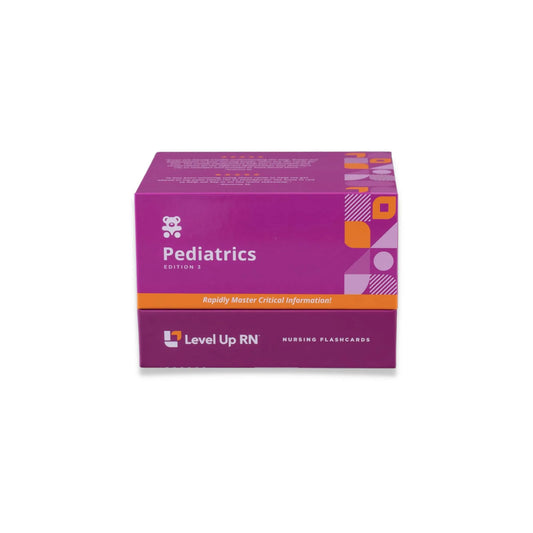Hi, I'm Cathy with Level Up RN. In this video, I will be discussing immobilization devices. Specifically, I will be covering key information that you have to know in nursing school about casts and traction. And at the end of the video, I'm going to give you guys a little quiz to test your knowledge of some of the key points I'll be covering, so definitely stay tuned for that. And if you have our Level Up RN pediatric nursing flashcards, go ahead and pull those out so you can follow along with me and pay close attention to the bold red text on these cards because those represent the most important facts that you are likely to get tested on in nursing school.
The first immobilization device we're going to talk about is a cast, so let's go over some important nursing care and patient teaching that you definitely have to know for your nursing school exam. So first of all, you want to elevate the cast and apply ice for the first 24 hours. You want to handle the cast with your palms and not your fingertips in order to prevent denting until the cast is dry. Your patient can use moleskin around any rough edges of the cast, and you should advise your patient to never insert objects into the cast. If they have itching, they can blow cool air from a hairdryer inside the cast in order to relieve that itching. And then the following symptoms should be reported to their provider: hotspots, increased drainage, malodor, increased pain, cool digits, and/or a change in distal extremity color. For patients with a hip spica cast which may be used for things such as a femur fracture, it's important to monitor for constipation. Because the child has decreased mobility in the cast and may be taking pain medication, this can result in constipation, so we need to advise our child's family to increase the child's intake of fiber and fluid.
Let's now review the different types of traction that may be used in the treatment of a fracture or other musculoskeletal disorder. Skin traction is where weights are attached to the patient's skin in order to immobilize the area, decrease muscle spasms, and realign bones. Examples of skin traction include Bryant traction and Buck's traction. Skeletal traction is used for long bone fractures, such as a femur fracture. With this type of traction, screws or pins are inserted into the bone, and then weights are attached to pull the bone into the correct position. And then halo traction is used for cervical bone fractures as well as other disorders. With this type of traction, we have a metal ring or halo that is attached to the skull using pins or screws. So if you look in your textbook for a picture of halo traction, you will see a very unhappy person, and that is legit. I have cared for a number of patients with halo traction, and they are quite justifiably not having a good time while that halo traction is in place.
Let's now discuss nursing care of a patient who is receiving traction. So first of all, we would never lift or remove weights, and we would never let weights just rest on the floor. They need to be hanging freely. Muscle spasms are expected and should be treated with medications such as analgesics and muscle relaxants, as well as repositioning, heat, and massage. If the patient's muscle spasms are unrelieved with those interventions, then you would notify the provider. In terms of caring for a patient receiving halo traction, it's important that we never apply pressure to the rods. And then we also need to make sure a wrench or screwdriver is attached to the vest so that we can release the patient from the device in the event of an emergency. And then in terms of pin site care, we need to monitor for pin loosening, skin tenting, and signs of infection, which include increased drainage and erythema. And then we should clean pins with the prescribed cleaning solution, making sure to use a new cotton-tip swab for each pin.
All right. It's quiz time, and I've got three questions for you.
Question number one. How should a child relieve itching inside their cast? The answer is they should blow cool air from a hairdryer inside the cast to help relieve itching. They should never place objects inside the cast.
Question number two. For skeletal traction, weights should remain on the floor at all times. True or false? The answer is false. Weights should hang freely at all times, and they should not rest on the floor.
Question number three. What type of traction involves the use of a metal ring that is attached to the skull using pins or screws? The answer is halo traction.
All right. That is it for this video. I hope you found it to be helpful. Thank you so much for watching, and good luck with studying.
[BLOOPERS]
The answer is they should blew blew blew blew blew blow cold air.


